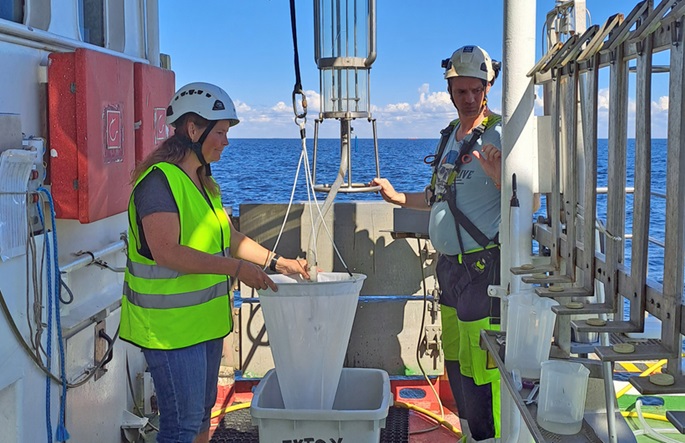Oxygen conditions of Finnish seas water remain poor
Published : 31 Oct 2024, 02:38
Updated : 31 Oct 2024, 03:14
The oxygen situation in the deep waters of the open Gulf of Finland remains poor, and the seabeds are generally dead at depths over 60 meters, according to a monitoring report published by the Finnish Environment Institute (SYKE) on Wednesday.
The marine research vessel Aranda and the coastal monitoring vessel of the SYKE conducted the late summer monitoring cruises and found that the influx of saline water at the end of last year was not sufficient to improve the oxygen conditions in the deep waters of the main basin.
The state of the Bothnian Bay is still better than the southern sea areas. However, its phosphorus content has increased, and the oxygen situation in the deep waters of the Bothnian Sea has deteriorated.
The eutrophication of the southern coastal waters is generally at a moderate or poor level.
“The results of the summer monitoring cruises were not surprising, and no major changes in the state of the Baltic Sea were observed. The work to improve the state of the Baltic Sea is long-term and requires continuous monitoring. The results of the work are visible with a delay, and without all the efforts, the state of the sea would certainly be worse,” said Aranda’s expedition leader, senior researcher Pekka Kotilainen of SYKE.
The research vessel Aranda’s August cruise focused on the Gulf of Finland, the Archipelago Sea, the Gulf of Bothnia, and the northern parts of the Baltic Proper. At the same time, a coastal monitoring cruise was conducted with the vessel Hessu in the Gulf of Finland and the Archipelago Sea.
In addition to nutrient and oxygen samples, information was collected on algal toxins, changes in benthic fauna and plankton communities, and variables that describe the effects of climate change on the marine environment.
Late summer nutrient observations are important for the Baltic Marine Environment Protection Commission’s (HELCOM) assessment of the eutrophication situation.
The oxygen situation in the deep waters of the open Gulf of Finland also remained poor. This increases the amount of nutrients that cause eutrophication, as phosphorus reserves in the bottom sediments are released, increasing the amount of phosphate phosphorus in the bottom waters.
Based on observations in June, benthic fauna appeared only in a small part of the open sea observation stations. At depths over 60 meters, the seabeds were generally dead, especially in the western and central Gulf of Finland. The seabed is considered dead when oxygen is depleted, and oxygen-dependent bottom-dwelling animals and fish have disappeared from the area.
Blue-green algae were present throughout the Gulf of Finland, although no actual algal blooms were observed in the open sea during the August cruise. Moon jellyfish, which have been abundant along the Finnish coasts this year, were observed especially in the western Gulf of Finland.
The deep water in the main basin was oxygen-free from 80 meters downwards, and the observed hydrogen sulfide levels were higher than the long-term average. This is due to the accelerated decomposition of organic matter. The concentrations of dissolved nutrients in the surface layer were typically low for the time of year.
No signs of the influx of saline water that entered the Baltic Sea in December 2023 were observed in the samples taken during the research cruise.
No significant changes were observed in the oxygen and nutrient situation in the deep waters of the Bothnian Sea.
The oxygen levels in the deep waters have decreased during the 2000s but are still at a relatively good level. The phosphorus levels in the Bothnian Sea have increased throughout the 2000s.
The levels of dissolved phosphorus in the Bothnian Bay have also been rising since the 2010s. Blue-green algae were observed in the surface water in some places during the cruise. Blue-green algae are not observed every year in the open sea of the Bothnian Bay.
Due to the decomposition of organic matter, lower oxygen levels and elevated silicate and ammonium nitrogen levels were also observed in the surface layer.
The oxygen situation in the bottom waters of the Archipelago Sea was moderate. The levels of dissolved phosphorus were higher than the long-term averages for the time of year.
Observations from central Gulf of Finland and northern Archipelago Sea support the results of the recent report on the state of Finland’s marine environment.
The state of the coastal waters in the Archipelago Sea and the Gulf of Finland is moderate or poor. The level of eutrophication has remained the same in most areas and indicators since the 1990s.
In both the Gulf of Finland and the Archipelago Sea, the effects of eutrophication were visible in some places as deteriorated oxygen conditions even in relatively shallow coastal depths.
The state of the benthic fauna communities was poor, or they were completely absent in the outer archipelago of the Gulf of Finland, where the influence of the deep water of the main basin of the Baltic Sea is most evident. At observation sites where oxygen was depleted, or its concentration was low, significantly elevated levels of phosphate phosphorus were measured.


